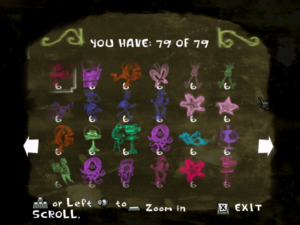Psychonauts: Collection
 Psychonauts has a fairly complicated system of item collection, and it’s instructive to compare it to that seen in Lego Star Wars 2 (described previously in this blog). I described the latter as byzantine and difficult to understand, with its multiple goals and overlapping effects. Now, Psychonauts has more types of collectible. In the real world sections, there are:
Psychonauts has a fairly complicated system of item collection, and it’s instructive to compare it to that seen in Lego Star Wars 2 (described previously in this blog). I described the latter as byzantine and difficult to understand, with its multiple goals and overlapping effects. Now, Psychonauts has more types of collectible. In the real world sections, there are:
- Psi challenge markers: few in number and located in difficult-to-reach places
- Psi cards: fragments that can be assembled into new psi challenge markers. More numerous and usually easy to reach, but often hard to spot
- Scavenger hunt items: unique objects, most of which require solving an optional puzzle
And in the mental realms:
- Figments of the imagination: all over the place, sometimes moving
- Mental cobwebs: collectible only using a special piece of equipment, and can be turned into psi cards back in the real world
- Memories: located in ambulatory safes that flee your approach; when collected, offer glimpses into character backstory
- Emotional baggage: a two-step collectible that involves finding a tag to match with each bag; matching all five in a mind unlocks some production art
However, I find the collection in Psychonauts easier to follow, and I think it’s mainly because the effects are simpler. With the exception of the effects mentioned above of the memories and the emotional baggage (which don’t seem to affect gameplay, and can be classed as “extras”), the end result of collection is always the same: increasing your “rank”. Attaining certain ranks grants permission to buy new equipment, or allows you to learn new powers, or enhances the powers you have. By funneling everything through the “rank” concept, the game simplifies the way you can think about gaining access to stuff. I suppose that this is something that RPGs have been doing all along with character levels, but it’s unusual to see a level system that isn’t at all based on gaining experience through combat.
Now, getting all the collectibles in everyone’s mental worlds typically involves going through them more than once. Indeed, it’s completely impossible to collect mental cobwebs from the first couple of minds on your first visit, as you don’t yet have access to the necessary equipment. It’s not uncommon in these games for collection to involve repeat visits to completed levels, but it’s usually handled non-diegetically: to use Lego Star Wars as an example again, if you replay the Battle of Hoth level, there’s no sense that you’re creating a story in which the Battle of Hoth was fought more than once. In Psychonauts, however, every visit is taken to be part of the same ongoing story, even if this requires convoluted excuses. So, the first time train with Sasha Nein, his mental defenses spin out of control and he urgently needs your help to restore order, but when you go back, Sasha offers to put you through the same “training course”, explaining that the emergency was a ruse to motivate you.
A more extreme example: In the mental landscape of the monster lungfish, it’s Raz who’s the monster, a Godzilla-like building-crumbling behemoth attacking Lungfishopolis. When you complete the level, by destroying a certain broadcast tower (the lungfish’s mental representation of the crainial implants that the bad guys are using to control it), the lungfish of the city are freed from their brainwashing and come to regard you as a hero. On a return visit, you’re cordially greeted by a lungfish who warns you that there are still some crazy guys out there who “don’t realize that the war is over”, and invites you to destroy as many buildings as you want: now that they’re free, they realize that lungfish were meant to live in mucus-lined bubbles at the bottom of lakes, not in tower blocks.
These scenes make a virtue of a constraint: they treat an unlikely situation resulting from gameplay decisions as an opportunity for humor. Or possibly the other way around: they use the fact that this is a humorous game as an excuse to integrate gameplay decisions with the story in ways that would be implausible if taken seriously. Whichever way it goes, it’s something that Schafer has been doing since his Lucasarts days.
 Comments(0)
Comments(0)